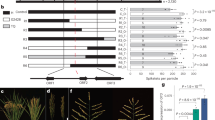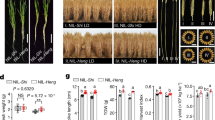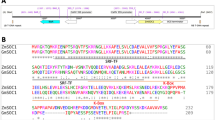Abstract
The 'green revolution' was fueled by the introduction of the semi-dwarf trait into cereal crop cultivars. The semi-dwarf cultivars—which respond abnormally to the plant growth hormone gibberellin (GA)—are more resistant to wind and rain damage and thus yield more grain when fertilized. To generate dwarf rice plants using a biotechnological approach, we modified the level of GA by overproduction of a GA catabolic enzyme, GA 2-oxidase. When the gene encoding GA 2-oxidase, OsGA2ox1, was constitutively expressed by the actin promoter, transgenic rice showed severe dwarfism but failed to set grain because GA is involved in both shoot elongation and reproductive development. In contrast, OsGA2ox1 ectopic expression at the site of bioactive GA synthesis in shoots under the control of the promoter of a GA biosynthesis gene, OsGA3ox2 (D18), resulted in a semi-dwarf phenotype that is normal in flowering and grain development. The stability and inheritance of these traits shows the feasibility of genetic improvement of cereal crops by modulation of GA catabolism and bioactive GA content.
This is a preview of subscription content, access via your institution
Access options
Subscribe to this journal
Receive 12 print issues and online access
$209.00 per year
only $17.42 per issue
Buy this article
- Purchase on Springer Link
- Instant access to full article PDF
Prices may be subject to local taxes which are calculated during checkout





Similar content being viewed by others
References
Evans, L.T. Crop Evolution, Adaptation and Yield (Cambridge Univ. Press, Cambridge, UK, 1993).
Hedden, P. & Phillips, A.L. Gibberellin metabolism: new insights revealed by the genes. Trends Plant Sci. 5, 523–530 (2000).
Thomas, S.G., Phillips, A.L. & Hedden, P. Molecular cloning and functional expression of gibberellin 2-oxidases, multifunctional enzymes involved in gibberellin deactivation. Proc. Natl. Acad. Sci. USA 96, 4698–4703 (1999).
Hedden, P. & Phillips, A.L. Manipulation of hormone biosynthetic genes in transgenic plants. Curr. Opin. Biotechnol. 11, 130–137 (2000).
Sakamoto, T. et al. Expression of a gibberellin 2-oxidase gene around the shoot apex is related to phase transition in rice. Plant Physiol. 125, 1508–1516 (2001).
Evans, M.M. & Poethig, R.S. Gibberellins promote vegetative phase change and reproductive maturity in maize. Plant Physiol. 10, 475–487 (1995).
Blazquez, M.A., Green, R., Nilsson, O., Sussman, M.R. & Weigel, D. Gibberellins promote flowering of Arabidopsis by activating the LEAFY promoter. Plant Cell 10, 791–800 (1998).
Itoh, H. et al. Two differently expressed gibberellin 3β-hydroxylase genes are involved in the regulation of growth of rice. Proc. Natl. Acad. Sci. USA 98, 8909–8914 (2001).
Sasaki, A. et al. A mutant of gibberellin-synthesis gene in rice. Nature 416, 701–702 (2002).
Ueguchi-Tanaka, M. et al. Rice dwarf mutant d1, which is defective in the α subunit of the heterotrimeric G protein, affects gibberellin signal transduction. Proc. Natl. Acad. Sci. USA 97, 11638–11643 (2000).
Kaneko, M. et al. Where do gibberellin biosynthesis and gibberellin signaling occur in rice plants? Plant J. 35, in the press (2003).
Khush, G.S. Green revolution: preparing for the 21st century. Genome 42, 646–655 (1999).
Peng, J. et al. 'Green revolution' genes encode mutant gibberellin response modulators. Nature 400, 256–261 (1999).
Coles, J.P. et al. Modification of gibberellin production and plant development in Arabidopsis by sense and antisense expression of gibberellin 20-oxidase genes. Plant J. 17, 547–556 (1999).
Itoh, H. et al. Modification of rice plant height by suppressing the height-controlling gene, D18, in rice. Breed. Sci. 52, 215–218 (2002).
Kobayashi, M., Sakurai, A., Saka, H. & Takahashi, N. Quantitative analysis of endogenous gibberellins in normal and dwarf cultivars of rice. Plant Cell Physiol. 30, 963–969 (1989).
Tanaka, H. et al. Ultra-fast transformation technique for monocotyledons. PCT Application, WO 01/06844 A1 (2001).
Acknowledgements
This work was supported, in part, by the Rice Genome Project from the Ministry of Agriculture, Forestry and Fisheries of Japan (IP-1010 to T.S.), by a grant-in-aid for scientific research from the Ministry of Education, Culture, Sports, Science and Technology of Japan (11306003 to S.I.) and by a grant from the Program for Promotion of Basic Research Activities for Innovation of Biosciences of Japan (to M.M. and H.T.).
Author information
Authors and Affiliations
Corresponding authors
Ethics declarations
Competing interests
The authors declare no competing financial interests.
Rights and permissions
About this article
Cite this article
Sakamoto, T., Morinaka, Y., Ishiyama, K. et al. Genetic manipulation of gibberellin metabolism in transgenic rice. Nat Biotechnol 21, 909–913 (2003). https://doi.org/10.1038/nbt847
Received:
Accepted:
Published:
Issue Date:
DOI: https://doi.org/10.1038/nbt847
This article is cited by
-
Candidate gene mining of GA-mediated regulation of pear fruit shape
Horticulture, Environment, and Biotechnology (2024)
-
Involvement of MYB family transcription factors, WsMYBL1 and WsMYBL2, in withanolide biosynthesis in Withania somnifera, a medicinal plant
Plant Cell, Tissue and Organ Culture (PCTOC) (2024)
-
Cytological, transcriptome and miRNome temporal landscapes decode enhancement of rice grain size
BMC Biology (2023)
-
Uncovering the involvement of DoDELLA1-interacting proteins in development by characterizing the DoDELLA gene family in Dendrobium officinale
BMC Plant Biology (2023)
-
UV-B irradiation-activated E3 ligase GmILPA1 modulates gibberellin catabolism to increase plant height in soybean
Nature Communications (2023)



